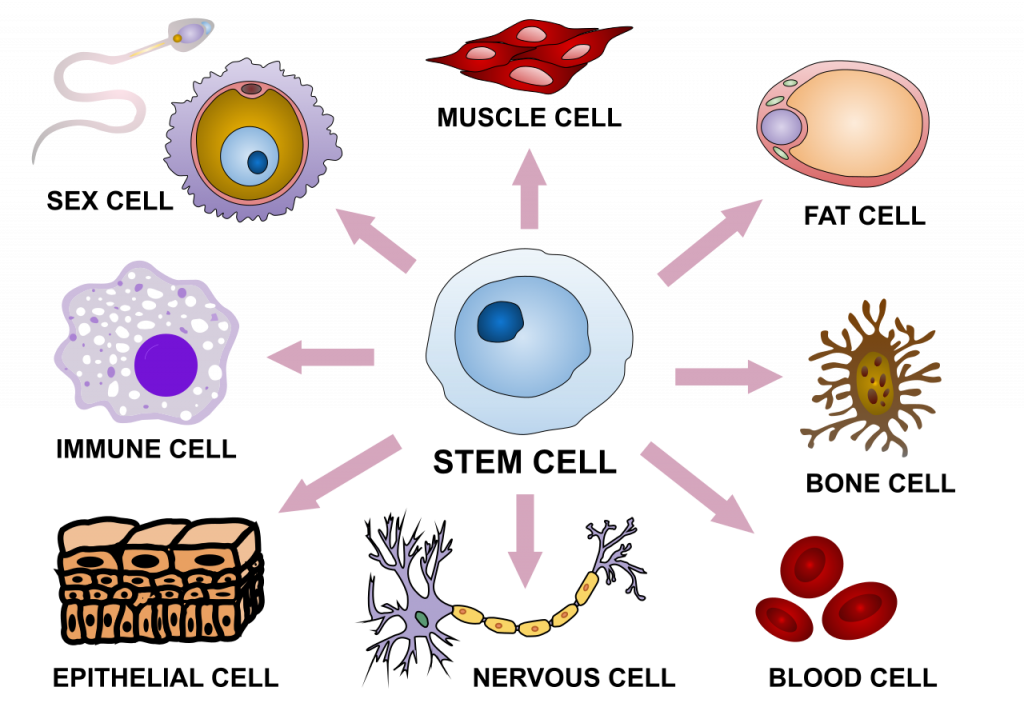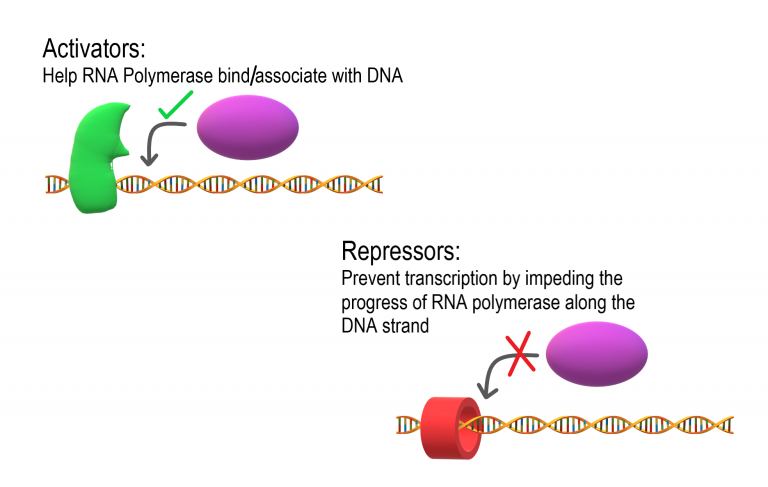9.4 Regulation of Gene Expression

Figure 9.4.1 Description
Diagram of stem cell differentiation showing a central stem cell giving rise to various specialized cell types. Arrows point outward to different cells, including sperm, egg, muscle cell, fat cell, immune cell, bone cell, epithelial cell, nerve cell, and red blood cells, illustrating the potential of stem cells to develop into diverse cell types.
This sketch illustrates some of the variability in human cells. The shape and other characteristics that make each type of cell unique depend mainly on the specific proteins that particular cell type makes. Proteins are encoded in genes. All the cells in an organism have the same genes and genetic instructions for the same proteins. Obviously, different types of cells must use (or express) different genes to make different proteins.
Gene Expression
For a cell to function properly, necessary proteins must be synthesized at the proper time. All cells control or regulate the synthesis of proteins from information encoded in their DNA. Turning on a gene to produce RNA and protein is called gene expression. Whether in a simple unicellular organism or a complex multi-cellular organism, each cell controls when and how its genes are expressed. For this to occur, there must be a mechanism to control when a gene is expressed to make RNA and protein, how much of the protein is made, and when it is time to stop making that protein because it is no longer needed.
The regulation of gene expression conserves energy and space. It would require a significant amount of energy for an organism to express every gene at all times, so it is more energy-efficient to turn on the genes only when they are required. In addition, only expressing a subset of genes in each cell saves space because DNA must be unwound from its tightly coiled structure to transcribe and translate the DNA. Cells would have to be enormous if every protein were expressed in every cell all the time.
The control of gene expression is extremely complex. Malfunctions in this process are detrimental to the cell and can lead to the development of many diseases.
Gene Regulation
Gene regulation is how a cell controls which genes, out of the many genes in its genome, are “turned on” (expressed). Thanks to gene regulation, each cell type in your body has a different set of active genes—even though almost all the cells of your body contain the exact same DNA. These different gene expression patterns cause your various cell types to have different sets of proteins, making each cell type uniquely specialized to do its job.
For example, one of the jobs of the liver is to remove toxic substances like alcohol from the bloodstream. To do this, liver cells express genes encoding subunits (pieces) of an alcohol dehydrogenase enzyme. This enzyme breaks alcohol down into a non-toxic molecule. The neurons in a person’s brain don’t remove toxins from the body, so they keep these genes unexpressed or “turned off.” Similarly, the liver cells don’t send signals using neurotransmitters, so they turn neurotransmitter genes off. Many other genes are expressed differently between liver cells and neurons (or any two cell types in a multicellular organism like yourself).

Figure 9.4.2 Description
Diagram comparing gene expression in a generic cell and a neuron. Both cells contain the same DNA but express different genes. In the generic cell, a blue gene is transcribed into RNA, while a purple gene is not. In the neuron, the purple gene is transcribed into RNA, but the blue gene is not. This demonstrates that different cell types express different sets of genes despite having identical DNA.
Prokaryotic Gene Regulation
Prokaryotic organisms are single-celled organisms that lack a cell nucleus, so their DNA floats freely in the cytoplasm. Because of this, transcription and translation occur almost simultaneously when synthesizing a protein. As a result, the primary method to control what type of protein and how much of each protein is expressed in a prokaryotic cell is through the regulation of transcription.
In many cases, prokaryotic genes are “on” by default, meaning they are actively transcribed unless something represses them. This allows prokaryotes to respond quickly to environmental changes. When the protein product is no longer needed, repressors prevent further transcription. A repressor is a protein that binds to a specific DNA sequence and blocks transcription. When more protein is required, the repressor is removed or inactivated, allowing transcription to resume.
Eukaryotic Gene Regulation
Eukaryotic cells have intracellular organelles that add to their complexity. Their DNA is contained inside the cell’s nucleus, and it is transcribed into RNA. The newly synthesized RNA is then transported from the nucleus into the cytoplasm, where ribosomes translate the RNA into protein. The nuclear membrane physically separates the processes of transcription and translation; transcription occurs only within the nucleus, and translation occurs only outside the nucleus in the cytoplasm. The regulation of gene expression can occur at all stages of the process.
Gene expression is regulated to ensure the correct proteins are made when and where needed.
Regulation may occur at any point in the expression of a gene, from the start of the transcription phase of protein synthesis to the processing of a protein after synthesis occurs.
Epigenetic Regulation
Epigenetic markers are chemical tags that attach to DNA or histone proteins to make certain genes more accessible. Think of sticky notes in a cookbook to flag your favourite recipes to make that information easier to find and read. Similarly, epigenetic markers flag certain genes, making them easier to access for transcription.
Transcriptional Regulation
Transcription is controlled by regulatory proteins which bind to DNA regions near promoters. Activators are regulatory proteins that promote transcription by enhancing the interaction of RNA polymerase with the promoter. They help initiate gene expression when a specific protein is needed. Repressors are regulatory proteins that inhibit transcription by blocking or interfering with RNA polymerase’s ability to move along the DNA strand. This prevents the gene from being transcribed into mRNA.
In eukaryotic cells, most genes are “off” by default and require activators and other signals to be turned on. This tight regulation ensures that proteins are produced only when and where they are needed, which is especially important in multicellular organisms with specialized cells.

Figure 9.4.3 Description
Diagram explaining the roles of activators and repressors in gene regulation. The top section shows an activator protein helping RNA polymerase bind to DNA, allowing transcription to proceed. The bottom section shows a repressor protein blocking RNA polymerase from moving along the DNA, preventing transcription.
Post-Transcriptional Regulation
After transcription, mRNA is processed, and the introns are removed by splicing. Alternative RNA splicing is a mechanism that allows different protein products to be produced from one gene when different combinations of introns (and sometimes exons) are removed from the transcript.

Figure 9.4.4 Description
Diagram showing alternative splicing of pre-mRNA. The pre-mRNA contains exons labelled 1 to 4 and introns in between. Two different spliced mRNA variants are produced: one includes exons 1, 2, and 3; the other includes exons 1, 3, and 4, demonstrating how a single gene can produce different mRNA transcripts.
Translational Regulation
Post-Translational Regulation
Exercise 9.4.1
Text Description
- only the transcriptional level
- epigenetic and transcriptional levels
- epigenetic, transcriptional, and translational levels
- epigenetic, transcriptional, post-transcriptional, translational, and post-translational levels
- the regulation of gene expression after transcription
- the regulation of gene expression after translation
- the control of epigenetic activation
- the period between transcription and translation
Answers
“5.9 Regulation of Gene Expression” from Human Biology by Christine Miller is licensed under a Creative Commons Attribution-NonCommercial 4.0 International License, except where otherwise noted.
“Regulation of Gene Expression” from Biology for Majors I by Shelli Carter and Lumen Learning is licensed under Attribution 4.0 International, except where otherwise noted.

